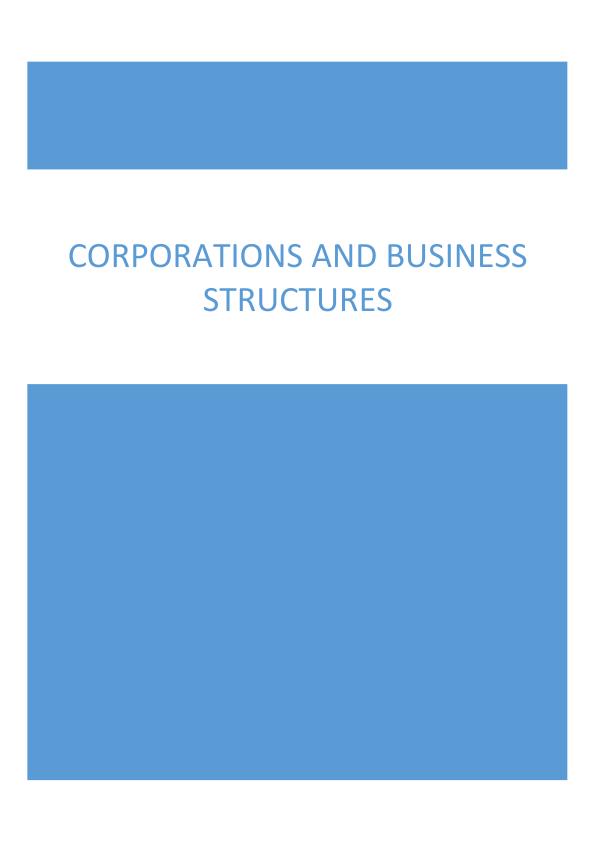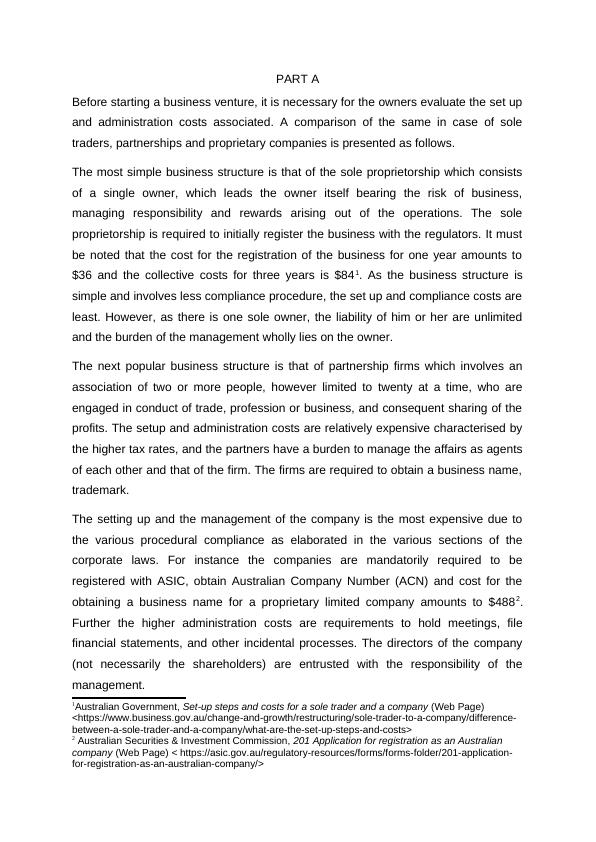Corporations and Business Structures
Added on 2023-01-20
6 Pages2102 Words41 Views
CORPORATIONS AND BUSINESS
STRUCTURES
STRUCTURES

PART A
Before starting a business venture, it is necessary for the owners evaluate the set up
and administration costs associated. A comparison of the same in case of sole
traders, partnerships and proprietary companies is presented as follows.
The most simple business structure is that of the sole proprietorship which consists
of a single owner, which leads the owner itself bearing the risk of business,
managing responsibility and rewards arising out of the operations. The sole
proprietorship is required to initially register the business with the regulators. It must
be noted that the cost for the registration of the business for one year amounts to
$36 and the collective costs for three years is $841. As the business structure is
simple and involves less compliance procedure, the set up and compliance costs are
least. However, as there is one sole owner, the liability of him or her are unlimited
and the burden of the management wholly lies on the owner.
The next popular business structure is that of partnership firms which involves an
association of two or more people, however limited to twenty at a time, who are
engaged in conduct of trade, profession or business, and consequent sharing of the
profits. The setup and administration costs are relatively expensive characterised by
the higher tax rates, and the partners have a burden to manage the affairs as agents
of each other and that of the firm. The firms are required to obtain a business name,
trademark.
The setting up and the management of the company is the most expensive due to
the various procedural compliance as elaborated in the various sections of the
corporate laws. For instance the companies are mandatorily required to be
registered with ASIC, obtain Australian Company Number (ACN) and cost for the
obtaining a business name for a proprietary limited company amounts to $4882.
Further the higher administration costs are requirements to hold meetings, file
financial statements, and other incidental processes. The directors of the company
(not necessarily the shareholders) are entrusted with the responsibility of the
management.
1Australian Government, Set-up steps and costs for a sole trader and a company (Web Page)
<https://www.business.gov.au/change-and-growth/restructuring/sole-trader-to-a-company/difference-
between-a-sole-trader-and-a-company/what-are-the-set-up-steps-and-costs>
2 Australian Securities & Investment Commission, 201 Application for registration as an Australian
company (Web Page) < https://asic.gov.au/regulatory-resources/forms/forms-folder/201-application-
for-registration-as-an-australian-company/>
Before starting a business venture, it is necessary for the owners evaluate the set up
and administration costs associated. A comparison of the same in case of sole
traders, partnerships and proprietary companies is presented as follows.
The most simple business structure is that of the sole proprietorship which consists
of a single owner, which leads the owner itself bearing the risk of business,
managing responsibility and rewards arising out of the operations. The sole
proprietorship is required to initially register the business with the regulators. It must
be noted that the cost for the registration of the business for one year amounts to
$36 and the collective costs for three years is $841. As the business structure is
simple and involves less compliance procedure, the set up and compliance costs are
least. However, as there is one sole owner, the liability of him or her are unlimited
and the burden of the management wholly lies on the owner.
The next popular business structure is that of partnership firms which involves an
association of two or more people, however limited to twenty at a time, who are
engaged in conduct of trade, profession or business, and consequent sharing of the
profits. The setup and administration costs are relatively expensive characterised by
the higher tax rates, and the partners have a burden to manage the affairs as agents
of each other and that of the firm. The firms are required to obtain a business name,
trademark.
The setting up and the management of the company is the most expensive due to
the various procedural compliance as elaborated in the various sections of the
corporate laws. For instance the companies are mandatorily required to be
registered with ASIC, obtain Australian Company Number (ACN) and cost for the
obtaining a business name for a proprietary limited company amounts to $4882.
Further the higher administration costs are requirements to hold meetings, file
financial statements, and other incidental processes. The directors of the company
(not necessarily the shareholders) are entrusted with the responsibility of the
management.
1Australian Government, Set-up steps and costs for a sole trader and a company (Web Page)
<https://www.business.gov.au/change-and-growth/restructuring/sole-trader-to-a-company/difference-
between-a-sole-trader-and-a-company/what-are-the-set-up-steps-and-costs>
2 Australian Securities & Investment Commission, 201 Application for registration as an Australian
company (Web Page) < https://asic.gov.au/regulatory-resources/forms/forms-folder/201-application-
for-registration-as-an-australian-company/>

PART B
The difference in the structure of the liability of partners of the partnership firm and
the liability of individuals involved in a proprietary company concerning the contracts
entered into with third parties, are presented below.
It must be noted that respective partnership acts of the states govern the matters of
the partnership and lead to the regulation of the rights and obligations of partners. In
Queensland, the Partnership Act, 1891 regulates the association of persons not the
companies who carry on business and a common view to earn profits3. It is essential
to note that the principle of equity and Partnership Acts regulate the matters of the
firm and relationship between the partners. It must be noted that while entering into
partnership, the partners may however decide to devise a customised contract
namely the partnership deed to elaborate the rights and obligations towards each
other as complementary to the partnership act on lines of the matters stated as
follows. These are relating to the sharing of profits, payment of remuneration,
governance duties, and financial controls, manner of the dissolution of the firm,
conditions for the retirements and admissions of the partners and others.
Nevertheless, when it comes to the contract in relation to the outside parties and the
consequent liabilities of the partners, the same cannot be decided by the partners on
their own and are as stated in the act. According to the act, the partners are joint
liable on all the partners for the debts and obligations concerning the firm’s business
that are incurred when being part of the partnership, as stated in the section 12 4. The
joint liability of the partners in the third party contact signifies that the partners will be
liable even when they do not have the knowledge of the contracts as entered into by
other partner or partners. Thus, the third parties can sue the contracts even when all
of the partners are not aware on the grounds of presumption that all the partners of
the firm are totally and equally liable for the acts of the firm. The significance of the
said liability is that in the event of the death of the partner, even the estate of the
partner is jointly and severally for the wrongful acts or omissions of a co-partner.
They can even be asked to contribute out of their personnel assets for the deeds of
another, because the partners are each other’s agents.
3 Partnership Act, 1891
4 Partnership Act, 1891, sec 12
The difference in the structure of the liability of partners of the partnership firm and
the liability of individuals involved in a proprietary company concerning the contracts
entered into with third parties, are presented below.
It must be noted that respective partnership acts of the states govern the matters of
the partnership and lead to the regulation of the rights and obligations of partners. In
Queensland, the Partnership Act, 1891 regulates the association of persons not the
companies who carry on business and a common view to earn profits3. It is essential
to note that the principle of equity and Partnership Acts regulate the matters of the
firm and relationship between the partners. It must be noted that while entering into
partnership, the partners may however decide to devise a customised contract
namely the partnership deed to elaborate the rights and obligations towards each
other as complementary to the partnership act on lines of the matters stated as
follows. These are relating to the sharing of profits, payment of remuneration,
governance duties, and financial controls, manner of the dissolution of the firm,
conditions for the retirements and admissions of the partners and others.
Nevertheless, when it comes to the contract in relation to the outside parties and the
consequent liabilities of the partners, the same cannot be decided by the partners on
their own and are as stated in the act. According to the act, the partners are joint
liable on all the partners for the debts and obligations concerning the firm’s business
that are incurred when being part of the partnership, as stated in the section 12 4. The
joint liability of the partners in the third party contact signifies that the partners will be
liable even when they do not have the knowledge of the contracts as entered into by
other partner or partners. Thus, the third parties can sue the contracts even when all
of the partners are not aware on the grounds of presumption that all the partners of
the firm are totally and equally liable for the acts of the firm. The significance of the
said liability is that in the event of the death of the partner, even the estate of the
partner is jointly and severally for the wrongful acts or omissions of a co-partner.
They can even be asked to contribute out of their personnel assets for the deeds of
another, because the partners are each other’s agents.
3 Partnership Act, 1891
4 Partnership Act, 1891, sec 12

End of preview
Want to access all the pages? Upload your documents or become a member.
Related Documents
Costs of Business Structureslg...
|7
|2189
|85
Corporations and Business Structurelg...
|13
|3732
|97
Corporation and Business Structurelg...
|8
|2352
|58
BUSINESS AND CORPORATION LAW.lg...
|10
|2673
|98
Corporations and Business Structureslg...
|8
|2430
|49
Comparison of Liabilities in Partnership and Company Structureslg...
|7
|2351
|22
